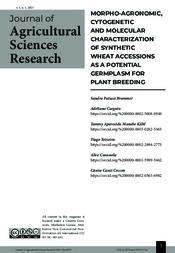Morpho-agronomic, cytogenetic and molecular characterization of synthetic wheat accessions as a potential germplasm for plant breeding.
Morpho-agronomic, cytogenetic and molecular characterization of synthetic wheat accessions as a potential germplasm for plant breeding.
Author(s): BRAMMER, S. P.; CARGNIN, A.; KIIHL, T. A. M.; RESENDE, T. T. de; CASASSOLA, A.; CECCON, C. C.
Summary: Synthetic hexaploid wheat (AABBDD) is produced by using the tetraploid Triticum turgidum var. durum (AABB) and the diploid Aegilops tauschii (DD) as parents. This cross has allowed genetic variability to be transferred from parental to other wheat hexaploid accessions, lines or cultivars. This transference may occur not only of variable disease resistance genes but also traits involving quality and tolerance to abiotic stresses. We evaluated and characterized the genetic diversity and stability of synthetic wheat accessions that can be used in breeding programs due to the presence of desirable characteristics. Fifty synthetic accessions were investigated regarding their morphological and agronomic characteristics, presence of micronuclei in tetrads and genetic similarity based on molecular markers. Four commercial cultivars were used as controls. Depending on their proposed use, some genotypes were characterised as suitable for breeding programs based on their morphological traits, genetic stability or genetic diversity, or because of a combination of these factors.
Publication year: 2021
Types of publication: Journal article
Unit: Embrapa Wheat
Keywords: Genetic, Genetic diversity, Genetic stability, Meiotic index, Microsatellite, Morphology
Observation
Some of Embrapa's publications are published as ePub files. To read them, use or download one of the following free software options to your computer or mobile device. Android: Google Play Books; IOS: iBooks; Windows and Linux: Calibre.
Access other publications
Access the Agricultural Research Database (BDPA) to consult Embrapa's full library collection and records.
Visit Embrapa Bookstore to purchase books and other publications sold by Embrapa.

